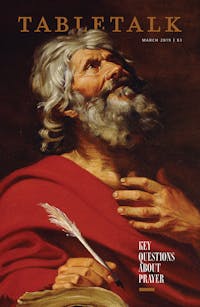
Request your free, three-month trial to Tabletalk magazine. You’ll receive the print issue monthly and gain immediate digital access to decades of archives. This trial is risk-free. No credit card required.
Try Tabletalk NowAlready receive Tabletalk magazine every month?
Verify your email address to gain unlimited access.
When God instituted the Passover, Moses said to the people of Israel:
When your children say to you, “What do you mean by this service?” you shall say, “It is the sacrifice of the Lord’s Passover, for he passed over the houses of the people of Israel in Egypt, when he struck the Egyptians but spared our houses.” (Ex. 12:26–27)
God knew that this ceremonial meal would raise questions in the minds of observers. The Lord’s Supper raises similar kinds of questions. Do we know how to answer those questions? Do we know what to say when our children ask us, “What is the Lord’s Supper?”
Our forefathers in the faith have bequeathed to us many helps for our task, including our confessions and catechisms. Westminster Larger Catechism 168, for example, deals with the question, “What is the Lord’s Supper?” The answer reads as follows:
The Lord’s Supper is a sacrament of the New Testament, wherein, by giving and receiving bread and wine according to the appointment of Jesus Christ, his death is showed forth; and they that worthily communicate feed upon his body and blood, to their spiritual nourishment and growth in grace; have their union and communion with him confirmed; testify and renew their thankfulness, and engagement to God, and their mutual love and fellowship each with the other, as members of the same mystical body.
The first thing we note about the Lord’s Supper is that it is a sacrament. But what is a sacrament? It is
a holy ordinance instituted by Christ in his church, to signify, seal, and exhibit unto those that are within the covenant of grace, the benefits of his mediation; to strengthen and increase their faith, and all other graces; to oblige them to obedience; to testify and cherish their love and communion one with another; and to distinguish them from those that are without. (WLC 162)
The catechism goes on to explain that sacraments have two parts: a visible outward sign and the spiritual reality signified by the sign (WLC 163). There are only two such sacraments instituted by Jesus Christ: baptism and the Lord’s Supper.
The Lord’s Supper as a sacrament signifies the benefits of Christ’s mediation. The bread and wine signify Christ crucified and His benefits (Westminster Confession of Faith 29.5, 7). More specifically, the bread is the sign of Christ’s body, and the wine is the sign of His blood (Matt. 26:26–28; 1 Cor. 10:16). Significantly, these signs are said to be united to the realities they signify. There is “a spiritual relation, or sacramental union, between the sign and the thing signified” (WCF 27.2). Because of this sacramental union, the sign is distinguished from that which it signifies, but it is not separated from it.
The Lord’s Supper is a seal because it confirms the promise of God regarding the reality of the benefits received by those who partake of the Lord’s Supper in faith. Those who partake in faith actually do “feed upon his body and blood” (WLC 168). The Lord’s Supper exhibits the benefits of Christ in the sense that those benefits are truly held forth to believers. This does not mean that the bread and wine have some kind of inherent power. The exhibition of the benefits of Christ depends wholly on the work of the Holy Spirit and the promise of God in the words of institution. But what are the benefits exhibited?
Worthy receivers outwardly partaking of the visible elements in this sacrament, do then also, inwardly by faith, really and indeed, yet not carnally and corporally, but spiritually, receive and feed upon Christ crucified, and all benefits of His death: the body and blood of Christ being then, not corporally or carnally, in, with, or under the bread and wine; yet, as really, but spiritually, present to the faith of believers in that ordinance, as the elements themselves are to their outward senses. (WCF 29.7)
The confession indicates that there is a parallel between what is happening outwardly and visibly and what is happening inwardly and invisibly. Believers really “receive and feed upon Christ crucified,” but not “carnally or corporally.” This happens spiritually because the body and blood of Christ are present to the faith of believers rather than being corporally present “in, with, or under the bread and wine.” This is the vertical aspect of the Lord’s Supper, the sacramental union between the invisible heavenly realities and the visible earthly actions and elements.
As we partake of Christ in the supper, we are spiritually nourished and thus grow in grace. Additionally, as we spiritually partake of the body and blood of Christ, our union with Him is strengthened. The Lord’s Supper is also an occasion to “testify and renew our thankfulness and engagement to God.” We are to remember Christ’s death on the cross for our sins and to thank God for His atoning work on our behalf.
There is also a horizontal aspect to the supper. As Augustine and John Calvin explained, the Lord’s Supper is a “bond of love” among believers. As we partake of the supper, we are to understand that we are all members of the same mystical body of Christ. If all Christians are united to Christ as their one Head, all Christians are united to one another in the one body of Christ. This understanding of our union with Christ and our communion with each other is to result in mutual love and fellowship, all to the glory of Christ (1 Cor. 11:17–34).
